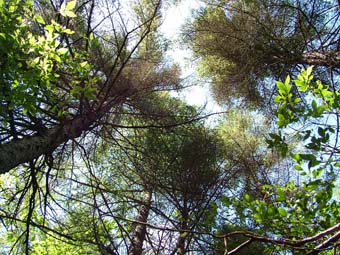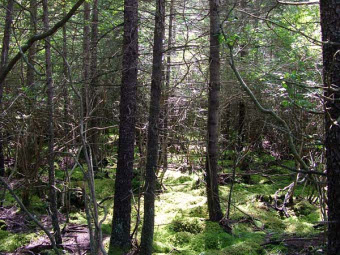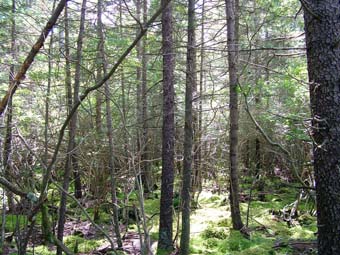Black Spruce – Tamarack Peatland Forest
System: Palustrine
Subsystem: Forest
PA Ecological Group(s): Peatland Wetland
Global Rank:G3G5
![]() rank interpretation
rank interpretation
State Rank: S3
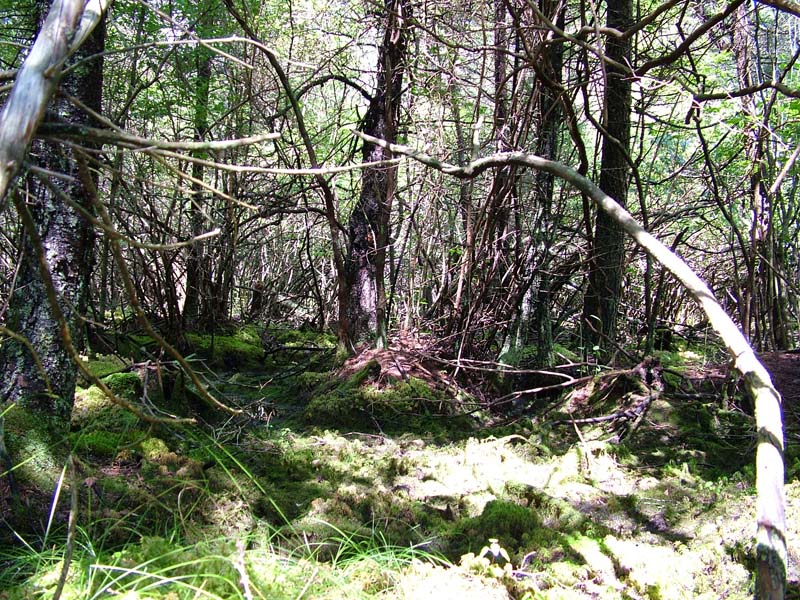
General Description
This describes a group of wetland forests found in glacially formed, ice-block depressions of small watersheds of the glaciated regions of Pennsylvania. These wetlands are dominated by a mixture of black spruce (Picea mariana) and tamarack (Larix laricina). The substrate is deep, poorly decomposed peat. There is generally very little groundwater or surface water enrichment in these systems except at the interface with uplands, leading to trees of small stature (< 40 ft.) in the inner portions of the wetland. Other trees that may occur include gray birch (Betula populifolia), red maple (Acer rubrum), Eastern hemlock (Tsuga canadensis), eastern white pine (Pinus strobus), and quaking aspen (Populus tremuloides). Hemlock and white pine often occur as a taller fringe at the outer edge of the wetland where organic soils give way to mineral; at this interface there is more nutrient input from surface and groundwater from the surrounding uplands.
Shrub species include swamp azalea (Rhododendron viscosum), leatherleaf (Chamaedaphne calyculata), mountain holly (Ilex mucronata), winterberry (Ilex verticillata), and highbush blueberry (Vaccinium corymbosum). The sedge, Carex trisperma, is often dominant along with a carpet of sphagnum mosses. Other species include star-flower (Trientalis borealis), cinnamon fern (Osmunda cinnamomea), violets (Viola spp.) creeping snowberry (Gaultheria hispidula), and goldthread (Coptis trifolia). Sphagnum occurs throughout.
Rank Justification
Vulnerable in the nation or state due to a restricted range, relatively few populations (often 80 or fewer), recent and widespread declines, or other factors making it vulnerable to extirpation.
Identification
- Occur on saturated peat soils in basins at the upper ends of small watersheds
- High elevations in Pennsylvania (1,000-2,000 ft.).
- Dense, tall black spruce and tamarack, along with leatherleaf in the canopy gaps
- 100% cover of Sphagnum spp. are excellent indicators.
Trees
Shrubs
* limited to sites with higher soil calcium
Vascular plant nomenclature follows Rhoads and Block (2007). Bryophyte nomenclature follows Crum and Anderson (1981).
International Vegetation Classification Associations:
USNVC Crosswalk:None
Representative Community Types:
Black Spruce Woodland Bog (CEGL006098)
NatureServe Ecological Systems:
North-Central Interior and Appalachian Acidic Peatland (CES202.606)
NatureServe Group Level:
None
Origin of Concept
Gawler, S. C. 2006. Lowbush Blueberry - American Mountain-ash / Shrubby Fivefingers Dwarf-shrubland (CEGL005094). NatureServe Explorer [web application]. NatureServe, Arlington, Virginia. Available https://explorer.natureserve.org/. (Accessed: January 27, 2022).
Pennsylvania Community Code*
UT : Black Spruce - Tamarack Peatland Forest
*(DCNR 1999, Stone 2006)
Similar Ecological Communities
This type is closely related to the Black Spruce – Tamarack Woodland plant community type, which may accompany it. The distinction between the two is the percent canopy cover; the forested type has greater than 60% cover by trees, the woodland type is less than 60% cover.
Fike Crosswalk
Black Spruce – Tamarack Peatland Forest
Conservation Value
This is a rare plant community in Pennsylvania that has an unusual array of species; it is habitat for both rare and common species of plants and animals that reside nowhere else in Pennsylvania, including pitcher-plant (Sarracenia purpurea), sundews (Drosera spp.), and the white-throated sparrow (Zonotrichia albicollis). This community provides wintering habitat for northern bird species of spruce forests and woodlands that migrate south during severe winters. Some rare species found in this community include dwarf mistletoe (Arceuthobium pusillum), blackpoll warbler (Dendroica striata), and snowshoe hare (Lepus americanus). This community can provide archaeological/historical data on past climates and species as the acidic conditions prevent breakdown of pollen and plant residue within the peat.
Threats
Black Spruce – Tamarack Peatland Forests occur where nutrient input from the surrounding watershed is minimal, and most occur in small watersheds at the origin of streams and where the bedrock is acidic. There is limited opportunity for surface water to add nutrients as it passes over the soils and rocks of the watershed before entering the wetland. Black Spruce – Tamarack Peatland Forests are threatened by habitat alteration in the small watersheds they occupy due to nutrient input from surrounding uplands, and alterations to the hydrologic regime (beaver dams, lowering or raising of water tables). Clearing and development of adjacent land can lead to an accumulation of run-off pollution and sedimentation. As global climate change progresses, many boreal characteristic species within this community type may be intolerable of increasing temperatures. Spruce budworm (Choristoneura fumiferana) and exotic invasive insects that feed on conifers may be a threat.
Management
A natural buffer around the wetland should be maintained in order to minimize nutrient runoff, pollution, and sedimentation. The potential for soil erosion based on soil texture, condition of the adjacent vegetation (mature forests vs. clearcuts), and slope should be considered when establishing buffers. As slope steepness increases the buffer should be extended. Impervious surfaces surrounding the wetland should be minimized to prevent thermal pollution. Direct impacts and habitat alteration should be avoided (e.g., roads, trails, filling of wetlands) and low-impact alternatives (e.g., elevated footpaths, boardwalks, bridges) should be utilized in situations where accessing the wetland cannot be avoided. Care should also be taken to control and prevent the spread of invasive species within the wetland. Increases from surface and groundwater sources should be minimized. Where disturbances are unavoidable, the wetland should be monitored for changes in vegetation, especially invasive species.
Research Needs
Variations may occur at eco-regional levels. To assist further classification, there is a need to collect community plot data to characterize variations of this community. It is possible that this community and other conifer wetland types have never been logged. Wetland history and tree age will provide information on the natural successional trajectory of this wetland, as well as the vegetation and landscape of Pennsylvania prior to large-scale development. Potential global climate change may greatly impact this community as Black Spruce Tamarack Peatland Forests are dependent upon specific temperature and precipitation regimes. This community type should be monitored for changes in species health and composition to determine if the community will persist in Pennsylvania.
Trends
The relative trend for this community is likely declining in the short term due to flooding from beaver activity. If natural succession is allowed to continue, many of the occurrences may recover over time, however global climate change may threaten this community.
Black Spruce – Tamarack Peatland Forests were probably more common in the northeast at one time but declined due to wetland draining for peat excavation, which was then followed by flooding for recreation. This type of alteration no longer occurs. Global climate change may be the biggest threat to this community type in Pennsylvania.
Range Map
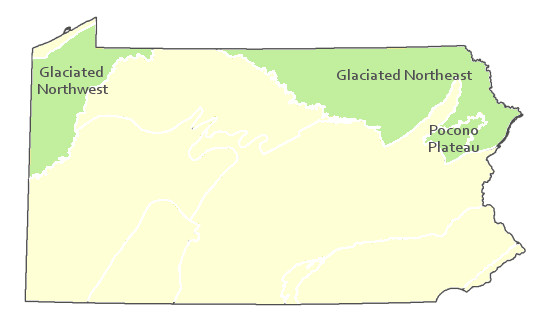
Pennsylvania Range
Glaciated NE, Glaciated NW, Pocono Plateau
Global Distribution
The association is found in northern and central New England, Michigan, New Jersey, New York, and northern Pennsylvania. It also occurs in eastern Canada.
Cowardin, L.M., V. Carter, F.C. Golet, and E.T. La Roe. 1979. Classification of wetlands and deepwater habitats of the United States. U.S. Fish and Wildlife Service. Washington, D.C. 131 pp.
Edinger, G. J., D.J. Evans, S. Gebauer, T. G. Howard, D. M. Hunt, and A. M. Olivero. 2002. Ecological Communities of New York State. Second Edition. A revised and expanded edition of Carol Reschke's Ecological Communities of New York State. New York Natural Heritage Program, New York State Department of Environmental Conservation. Albany, NY. 136 pp.
Fike, J. 1999. Terrestrial and palustrine plant communities of Pennsylvania. Pennsylvania Natural Diversity Inventory. Harrisburg, PA. 79 pp.
Johnson, C.W. 1985. Bogs of the Northeast. University Press of New England.
Larsen, J.A. 1982. Ecology of Northern Lowland Bogs and Conifer Forests. Academic Press, New York.
Merritt, J.F. 1987. Guide to the Mammals of Pennsylvania. University of Pittsburgh Press.
NatureServe. 2009. NatureServe Central Databases. Arlington, Virginia. USA
Pennsylvania Department of Conservation and Natural Resources (DCNR). 1999. Inventory Manual of Procedure. For the Fourth State Forest Management Plan. Pennsylvania Bureau of Forestry, Division of Forest Advisory Service. Harrisburg, PA. 51 ppg.
Rhoads, A.F. and T.A. Block. 2007. The Plants of Pennsylvania, 2nd ed. University of Pennsylvania Press.
Stone, B., D. Gustafson, and B. Jones. 2006 (revised). Manual of Procedure for State Game Land Cover Typing. Commonwealth of Pennsylvania Game Commission, Bureau of Wildlife Habitat Management, Forest Inventory and Analysis Section, Forestry Division. Harrisburg, PA. 79 ppg.
Thompson, E. 1996. Natural communities of Vermont uplands and wetland. Nongame and Natural Heritage Program, Department of Fish and Wildlife in cooperation with The Nature Conservancy, Vermont chapter.
Wenger, S. 1999. A Review of the Scientific Literature on Riparian Buffer Width, Extent and Vegetation. Office of Public Outreach, Institute of Ecology, Univ. of Georgia, Athens.
Cite as:
Davis T. 2022. Pennsylvania Natural Heritage Program. Black Spruce – Tamarack Peatland Forest Factsheet. Available from: https://naturalheritage.state.pa.us/Community.aspx?=16027 Date Accessed: March 29, 2025


